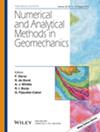A DEM Model for Assessing the Mechanical Effects of CO2 Alteration in a Carbonate Rock
IF 3.4
2区 工程技术
Q2 ENGINEERING, GEOLOGICAL
International Journal for Numerical and Analytical Methods in Geomechanics
Pub Date : 2025-05-10
DOI:10.1002/nag.3999
引用次数: 0
Abstract
CO碳酸盐岩中CO2蚀变力学效应的DEM模型
在地下注入二氧化碳被认为是提高油气产量的一种选择,最近又被认为是储存二氧化碳的一种选择。因此,有必要更好地了解二氧化碳和岩石沉积物之间的相互作用。主要的候选矿床是碳酸盐岩。在地下注入二氧化碳的过程中,地层孔隙结构和力学性质会因与二氧化碳的相互作用而发生改变,从而影响储层行为和流体流动。本研究旨在提高对CO2注入对碳酸盐岩力学行为影响的认识。利用实验室试验和数值离散元模型(dem)来评估二氧化碳注入对碳酸盐岩的影响。实验室测试包括对印第安纳州石灰石样品进行饱和二氧化碳注水和多级三轴测试。在注入二氧化碳前后分别进行了三轴试验,以研究岩石力学特性的变化。观察到无侧限抗压强度和杨氏模量的显著降低。建立了数值离散元模型来评估二氧化碳注入对碳酸盐岩的影响。接触定律解释了材料退化的机械效应。利用室内试验结果对数值模型进行了校正。数值方法得到了良好的结果,并通过与实验结果的匹配验证了数值方法的有效性,评估了印第安纳石灰石样品溶蚀引起的力学变化。
本文章由计算机程序翻译,如有差异,请以英文原文为准。
求助全文
约1分钟内获得全文
求助全文
来源期刊
CiteScore
6.40
自引率
12.50%
发文量
160
审稿时长
9 months
期刊介绍:
The journal welcomes manuscripts that substantially contribute to the understanding of the complex mechanical behaviour of geomaterials (soils, rocks, concrete, ice, snow, and powders), through innovative experimental techniques, and/or through the development of novel numerical or hybrid experimental/numerical modelling concepts in geomechanics. Topics of interest include instabilities and localization, interface and surface phenomena, fracture and failure, multi-physics and other time-dependent phenomena, micromechanics and multi-scale methods, and inverse analysis and stochastic methods. Papers related to energy and environmental issues are particularly welcome. The illustration of the proposed methods and techniques to engineering problems is encouraged. However, manuscripts dealing with applications of existing methods, or proposing incremental improvements to existing methods – in particular marginal extensions of existing analytical solutions or numerical methods – will not be considered for review.

 求助内容:
求助内容: 应助结果提醒方式:
应助结果提醒方式:


